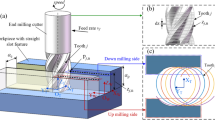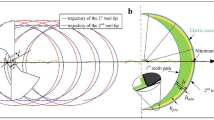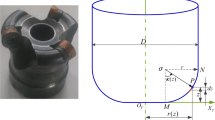Abstract
In this work, a theoretical analysis of surface generation numerical model is presented to predict the surface roughness achieved by side milling operations with cylindrical tools. This work is focused on the trajectory of tools with two teeth by the influence of tool errors such as radial runouts, as well as straightness with dynamic effects. A computational system was developed to simulate roughness topography in contour milling with cylindrical tool. Finally, the PSO (particle swarm optimization) algorithm is employed to find the optimal machining position for the best surface roughness. Experimental data is satisfied with the novel protection model for the tooth’s trajectory, and the final prediction accuracy is high enough, i.e. that the prediction surface roughness. Low prediction surface roughness error (1.37~15.04%) and position error (0.95~1.25 mm) indicate effectiveness of the model built in this work. The novel model may be used to determine the variation in surface roughness.














Similar content being viewed by others
Abbreviations
- L r [mm]:
-
The sampling length
- R a [μm]:
-
Average roughness
- R z [μm]:
-
Peaks and valleys (h)
- a p [mm]:
-
Radial depth of cut
- n [rpm]:
-
Spindle speed
- v [mm min−1]:
-
Feed speed
- R t [mm]:
-
The tool radius
- f Z [mm tooth−1]:
-
Feed per tooth
- h [mm]:
-
Maximum undeformed chip thickness
- α [°]:
-
Angle of teeth
- Z [No.]:
-
Number of teeth
- ε Y [μm]:
-
Radial runout
- ε X [μm]:
-
Axial runout
- Y X [μm]:
-
The straightness of Y in X direction
- ∆s [mm]:
-
Distance from processing position
References
BoothroydG Knight WA (2008) Book Review: fundamentals of machining and machine tools. Int J Microstruct Mater Prop 3.2:469–470
Dagnal H (1986) Exploring surface texture. Rank Taylor Habson Corp., England
Ikawa N, Donaldson RR, Komanduri R, König W, Aachen TH, McKeown PA, Moriwaki T, Stowers IF (1991) Ultraprecision metal cutting: the past, the present and the future. Ann CIRP 40(2):587–594
Spiewak S (1995) An improved model of the chip thickness in milling. CIRP Annals Manuf Technol 44:39–42
Irene BC, Joan VC, Hernán GR (2011) Influence of feed, eccentricity and helix angle on topography obtained in side milling processes. Int J Mach Tools Manuf 51(12):889–897
Budak E, Altintas Y (1995) Modeling and avoidance of static form errors in peripheral milling of plates. Int J Mach Tools Manuf 35:459–476
Franco P, Estrems M, Faura F (2008) A study of back cutting surface finish from tool errors and machine tool deviations during face milling. Int J Mach Tools Manuf 48:112–123
Chen ZT, Yue CX, Liang SY, Liu XL, Li HS, Li XC (2020) Iterative from error prediction for side-milling of thin-walled parts. Int J Adv Manuf Technol 107:4173–4189
Niu QL, Li PN, Chen M, Ming WW, Tang SW(2017) Analysis of chip serration phenomenon in side milling of ultrahigh-strength steel 30CrMnSiNi2A. Int J Adv Manuf Technol 88:985–993. https://doi.org/10.1007/s00170-016-8832-9
Li C, Wu YQ, Li XL, Ma LJ, Zhang FH, Huang H (2020) Deformation characteristics and surface generation modelling of crack-free grinding of GGG single crystals. J Mater Proces Technol 279:116577
Li C, Li XL, Huang SQ, Li LQ, Zhang FH (2021) Ultra-precision grinding of Gd3Ga5O12 crystals with graphene oxide coolant: material deformation mechanism and performance evaluation. J Manuf Proces 61(2021):417–427
Hao HY, Wang BS, Tang WC (2015) Prediction of instantaneous milling force taking runout into account in peripheral milling of curved surface. Int J Adv Manuf Technol 79:49–56
Chen T, Wang CH, Xiang JP, Wang YC (2020) Study on tool wear mechanism and cutting performance in helical milling of CFRP with stepped bi-directional milling cutters. Int J Adv Manuf Technol 111:2441–2448
Pan JF, Ni J, He LH, Cui Z, Feng K (2020) Influence of micro-structured milling cutter on the milling load and surface roughness of 6061 aluminum alloy. Int J Adv Manuf Technol 110:3201–3208
Hu ZH, Qin CJ, Shi ZW, Tang YR, Zhang XD, Zou YM (2020) An effective thread milling force prediction model considering instantaneous cutting thickness based on the cylindrical thread milling simplified to side milling process. Int J Adv Manuf Technol 110:1275–1283
Tomov M, Kuzinovski M, Cichosz P (2016) Development of mathematical models for surface roughness parameter prediction in turning depending on the process condition. Int J Mech Sci 113:120–132
Shi HR, Deok KC, Chong NC (2006) Roughness and texture generation on end milled surfaces. Int J Mach Tools Manuf 46(3–4):404–412
Franco P, Estrems M, Faura F (2004) Influence of radial and axial runouts on surface roughness in face milling with round insert cutting tools. Int J Mach Tools Manuf 44(15):1555–1565
Draghici G, Paltinea C (1974) Calculation by convex mathematical programming of the optimum cutting condition when cylindrical milling. Int J MachTool Design Res 14(2):143–160
Kruglov EI, Darymov OI (1978) Optimization of face milling. Mach Tool 49(3):35–37
Hough CL, Goforth RE (1981) Optimization of the second order logarithmic machining economics problem by extended geometric programming-part II posynomial constraints. Am Ins Indust Eng Trans 13:234
Ostafiev VA, Globa AV, Globa L (1984) Integrated end milling optimization development. Annals of CIRP 33(1):29–32
Eskicioglu AM, Eskicioglu H (1992) Application of three nonlinear programming techniques in optimizing machining conditions. Proceedings of Institution of Mechanical Engineers Part B 206:183–188
Zalnezhad E, Ahmed AD (2014) A fuzzy logic predictive model for better surface roughness of Ti–TiN coating on AL7075-T6 alloy for longer fretting fatigue life. Measurement 49:256–265
Chandrasekaran M, Devarasiddappa D (2014) Artificial neural network modeling for surface roughness prediction in cylindrical grinding of Al–SiCp metal matrix composites and ANOVA analysis. Adv Prod Eng Manag 9(2):59–70
Eberhart R, Kennedy J (1995) A new optimizer using particle swarm theory, MHS'95. Proceedings of the Sixth International Symposium on Micro Machine and Human Science, pp 39–43. https://doi.org/10.1109/MHS.1995.494215
ISO4287 (1997) Geometrical product specifications (GPS)-surface texture: profile method-terms, definitions and surface texture parameters
Funding
This research was funded by the National Natural Science Foundation of China (Grant No. 52005397), National Postdoctoral Program for Innovative Talents (Grant No. BX20180250), and Complete equipment project for ultra-precision processing of optical materials (TC190JED-207; TC190JED-210).
Author information
Authors and Affiliations
Contributions
Jinfeng Bai designed the research scheme and carried out the research process and so on. Huiying Zhao proposed research topic selection and guidance support. Lingyu Zhao and Mingchen Cao collected and organized the data. Duanzhi Duan investigated, organized, and revised the literature.
Corresponding author
Ethics declarations
Conflict of interest
The authors declare no competing interests.
Additional information
Publisher’s note
Springer Nature remains neutral with regard to jurisdictional claims in published maps and institutional affiliations.
Rights and permissions
About this article
Cite this article
Bai, J., Zhao, H., Zhao, L. et al. Modelling of surface roughness and studying of optimal machining position in side milling. Int J Adv Manuf Technol 116, 3651–3662 (2021). https://doi.org/10.1007/s00170-021-07463-y
Received:
Accepted:
Published:
Issue Date:
DOI: https://doi.org/10.1007/s00170-021-07463-y




